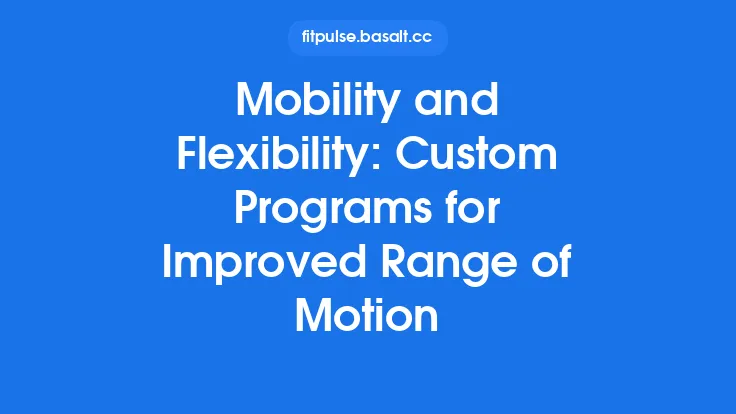High‑kick performance in striking arts such as Muay Thai, Taekwondo, and mixed‑martial arts hinges on more than raw power; it demands a harmonious blend of joint integrity, muscular length, and neural control. When a fighter can consistently deliver a round‑house or side kick at full extension without pain or loss of stability, they gain a decisive tactical edge. This article delves into the science‑based flexibility programs that expand kick range while safeguarding the hips, knees, and ankles. By understanding the underlying biomechanics, targeting the right tissues, and applying structured stretching methodologies, athletes can cultivate a durable, high‑kick arsenal that endures season after season.
Understanding the Biomechanics of High Kicks
A high kick is a multi‑joint movement that typically involves three kinetic chains:
- Hip Flexion/Extension – The primary driver of kick height. The gluteus maximus, hamstrings, and hip flexors coordinate to generate angular velocity.
- Knee Extension – Provides the final thrust and stabilizes the leg during impact. The quadriceps and gastrocnemius act as the main extensors.
- Ankle Dorsiflexion/Plantarflexion – Controls foot positioning and contributes to balance, especially in side‑kick variations.
The range of motion (ROM) at each joint is limited by a combination of muscular extensibility, capsular elasticity, and neural inhibition. When any of these components is compromised, the kick’s apex is reduced, and compensatory patterns (e.g., excessive lumbar extension) may emerge, increasing injury risk.
Key Anatomical Structures for Kick Range and Joint Health
| Structure | Role in High Kick | Flexibility Considerations |
|---|---|---|
| Hip Joint Capsule | Provides stability while allowing ~120° of flexion and ~45° of extension. | Capsular tightness limits extreme flexion; regular capsular mobilizations improve end‑range tolerance. |
| Iliopsoas & Rectus Femoris | Primary hip flexors that lift the thigh. | Lengthening these muscles expands the front‑kick and round‑house ceiling. |
| Gluteus Maximus & Hamstrings | Control hip extension and decelerate the leg. | Over‑tight hamstrings restrict hip extension; balanced stretching maintains reciprocal flexibility. |
| Adductors (Adductor Magnus, Longus, Brevis) | Stabilize the leg during lateral kicks. | Tight adductors impede side‑kick height; targeted adductor stretches are essential. |
| Quadriceps (Vastus Group) | Extend the knee at impact. | Excessive quadriceps tightness can limit knee extension and cause anterior knee stress. |
| Calf Complex (Gastrocnemius, Soleus) | Influence ankle dorsiflexion for foot placement. | Limited dorsiflexion forces compensatory hip or knee motion, jeopardizing joint health. |
| Thoracolumbar Fascia & Erector Spinae | Transfer force from the core to the leg. | Poor thoracic mobility can force the lumbar spine into hyperextension during high kicks. |
Principles of Effective Flexibility Training
- Specificity – Train the exact ROM required for each kick variant. A front‑kick demands deep hip flexion, while a side‑kick emphasizes hip abduction and external rotation.
- Progressive Overload – Gradually increase stretch intensity, duration, or load (e.g., using a partner’s gentle pressure) to stimulate tissue adaptation without triggering the protective stretch reflex.
- Frequency & Volume – High‑kick flexibility benefits from daily low‑to‑moderate volume (2–4 sets of 30–60 seconds per stretch) combined with periodic higher‑intensity sessions.
- Tissue Specificity – Different tissues respond uniquely: muscle fibers adapt to sustained static holds, while joint capsules respond better to low‑load, high‑repetition mobilizations.
- Neural Desensitization – Repeated exposure to end‑range positions reduces the central nervous system’s inhibitory response, allowing greater ROM over time.
Static Stretching Protocols for Maximum Reach
Static stretching remains a cornerstone for increasing muscular length. The following protocol targets the primary movers of a high round‑house kick:
- Supine Hip Flexor Stretch
- Position: Lie on the back, pull one knee toward the chest, and let the opposite leg extend straight on the floor.
- Hold: 45 seconds, repeat 3 times per side.
- Focus: Lengthen the iliopsoas and rectus femoris.
- Standing Hamstring Stretch with Pelvic Tilt
- Position: Place the heel on a low platform, hinge at the hips while maintaining a neutral pelvis.
- Hold: 60 seconds, 2 sets per leg.
- Emphasis: Avoid lumbar rounding to protect the spine.
- Adductor “Butterfly” Stretch
- Position: Sit with soles of feet together, gently press knees toward the floor using elbows.
- Hold: 45 seconds, 3 sets.
- Goal: Increase hip abduction capacity for side kicks.
- Quadriceps Stretch (Prone Knee‑to‑Chest)
- Position: Lie prone, grasp the ankle and draw the heel toward the glutes, keeping hips level.
- Hold: 30 seconds, 2 sets per leg.
- Calf Stretch with Dorsiflexion Emphasis
- Position: Stand facing a wall, place forefoot against the wall, and press the heel down while keeping the knee straight.
- Hold: 45 seconds, 2 sets per leg.
Key Tips:
- Perform stretches after a light aerobic warm‑up (5–10 minutes of jogging or jump rope) to raise tissue temperature.
- Breathe deeply; exhale as you gently deepen the stretch.
- Avoid “bouncing” to prevent reflexive muscle contraction.
Dynamic Stretching and Active Range‑of‑Motion Drills
Dynamic movements prepare the neuromuscular system for the rapid, ballistic nature of kicks. They also reinforce functional ROM through movement patterns that mimic combat scenarios.
| Drill | Execution | Targeted ROM |
|---|---|---|
| Leg Swings (Front‑to‑Back) | Stand on one leg, swing the opposite leg forward and backward in a controlled arc, gradually increasing height. | Hip flexion/extension, hamstring elasticity. |
| Leg Swings (Side‑to‑Side) | Same stance, swing leg laterally across the body, emphasizing hip abduction and external rotation. | Adductor and gluteal flexibility. |
| High‑Knee March with Hip Flexor Activation | March in place, driving the knee to chest while maintaining an upright torso; add a gentle backward lean to stretch the hip flexor. | Hip flexion, core stability. |
| Walking Lunges with Torso Rotation | Perform forward lunges, rotating the torso toward the front leg at the bottom of each lunge. | Hip flexors, thoracic rotation, quadriceps stretch. |
| Dynamic “Kick‑through” | From a low stance, execute a controlled round‑house kick, focusing on smooth, fluid motion rather than power. Perform 8–10 repetitions per side. | Full kick chain, neural coordination. |
Implementation:
- Perform 2–3 sets of each drill, 8–12 repetitions per set.
- Keep rest intervals short (15–30 seconds) to maintain a warm, active state.
- Use these drills as a bridge between static stretching and skill work.
Proprioceptive Neuromuscular Facilitation (PNF) for Advanced Flexibility
PNF leverages the stretch‑reflex and reciprocal inhibition to achieve greater ROM in a short time frame. The most common technique for high‑kick training is the Contract‑Relax‑Hold (CR‑H) method.
CR‑H Protocol for Hip Flexors:
- Passive Stretch – Partner or self‑assist the leg into a deep hip‑flexion stretch (e.g., supine hip‑flexor stretch). Hold for 10 seconds.
- Isometric Contraction – In the stretched position, contract the hip flexors by attempting to pull the thigh toward the torso without actual movement. Hold the contraction for 6 seconds.
- Relax & Deepen – Release the contraction, then gently increase the stretch by 5–10 degrees. Hold the new position for 20–30 seconds.
Repeat the cycle 2–3 times per session. The same pattern can be applied to adductors, hamstrings, and calves. PNF should be performed 2–3 times per week, with at least 48 hours between sessions for the same muscle group to allow tissue remodeling.
Myofascial Release and Tissue Quality
Fascia encases muscles, joints, and neurovascular structures; adhesions within this network can limit ROM and create pain points. Incorporating myofascial release (MFR) before or after stretching can improve tissue glide and enhance the effectiveness of flexibility work.
Tools & Techniques:
- Foam Roller (Medium‑density) – Roll the quadriceps, IT band, and gluteal region for 30–60 seconds each, focusing on tender spots.
- Lacrosse Ball – Target deep hip flexor trigger points by lying face‑down with the ball under the psoas region; hold 20–30 seconds per spot.
- Theracane or Massage Stick – Apply longitudinal pressure along the adductor line while in a supine position.
Guidelines:
- Apply moderate pressure (pain‑free to mildly uncomfortable).
- Avoid prolonged compression (>2 minutes) on a single spot to prevent tissue ischemia.
- Follow MFR with static or dynamic stretching to “reset” the lengthened state.
Integrating Yoga and Mobility Flow Sequences
Yoga offers a holistic approach that blends static holds, dynamic transitions, and breath control—elements that synergize with high‑kick flexibility goals.
Key Asanas for Kick Range:
- Warrior III (Virabhadrasana III) – Enhances hip extensors, hamstrings, and balance.
- Half‑Moon Pose (Ardha Chandrasana) – Opens the hip abductors and improves lateral stability.
- Pigeon Pose (Eka Pada Rajakapotasana) – Deeply stretches the gluteus maximus and external rotators, crucial for side‑kick rotation.
- Standing Forward Fold with Shoulder Opener – Lengthens the posterior chain while maintaining spinal alignment.
A 15‑minute flow can be performed 3–4 times weekly, preferably on low‑intensity training days. Emphasize Ujjayi breathing to maintain a calm nervous system, which aids in reducing stretch‑reflex inhibition.
Periodizing Flexibility: Micro‑Cycles, Macro‑Cycles, and Recovery
Just as strength and conditioning are periodized, flexibility training benefits from structured phases:
- Accumulation Phase (4–6 weeks) – Emphasize high‑frequency, low‑intensity static stretches and MFR to build baseline tissue length.
- Intensification Phase (3–4 weeks) – Introduce PNF, longer static holds (up to 90 seconds), and deeper yoga poses. Volume remains moderate to prevent over‑stretching.
- Peak Phase (1–2 weeks) – Focus on sport‑specific dynamic drills and high‑velocity kick repetitions at full ROM. Reduce static stretching to maintain joint stiffness needed for power transfer.
- Deload/Recovery Week – Cut stretch volume by 50 % and prioritize gentle MFR and restorative yoga to allow tissue remodeling.
Micro‑Cycle Example (Weekly):
| Day | Focus | Session Length |
|---|---|---|
| Mon | Static Stretch + MFR | 30 min |
| Tue | Dynamic Kick Drills + Light Yoga | 35 min |
| Wed | PNF + Foam Rolling | 30 min |
| Thu | Restorative Yoga + Mobility Flow | 25 min |
| Fri | High‑Intensity Dynamic Kicks + Active Stretching | 40 min |
| Sat | Full‑Body Stretch + MFR | 30 min |
| Sun | Active Recovery (light cardio, mobility) | 20 min |
Adjust the schedule based on competition cycles, training load, and individual recovery capacity.
Monitoring Progress and Adjusting Load
Objective tracking ensures that flexibility gains translate into functional kick height without compromising joint health.
- Kick Height Test – Measure the vertical distance from the ground to the tip of the foot during a maximal round‑house kick using a calibrated wall-mounted ruler or motion‑capture app. Record weekly.
- Passive ROM Goniometer – Assess hip flexion, extension, abduction, and external rotation angles. A 5°–10° increase over 8 weeks indicates effective adaptation.
- Joint Pain/Discomfort Log – Note any soreness, clicking, or instability after sessions. Persistent pain warrants a reduction in stretch intensity or a consultation with a sports‑medicine professional.
- Perceived Exertion (RPE) – Use a 0–10 scale during static holds; an RPE of 6–7 is optimal for flexibility without excessive strain.
When progress stalls, consider:
- Increasing Load – Add light resistance (e.g., ankle weights) during dynamic swings.
- Altering Stretch Duration – Longer holds (up to 90 seconds) can stimulate additional collagen remodeling.
- Modifying Frequency – If soreness accumulates, drop a session and focus on recovery modalities.
Common Mistakes and How to Avoid Them
| Mistake | Consequence | Corrective Action |
|---|---|---|
| Bouncing in Static Stretches | Triggers stretch reflex, limiting ROM and increasing strain risk. | Use slow, controlled movements; hold the stretch steadily. |
| Neglecting Opposing Muscle Groups | Creates muscular imbalances, leading to joint overload. | Pair hip flexor stretches with hamstring and glute work. |
| Over‑stretching Cold Muscles | Reduces tissue elasticity, heightening injury potential. | Warm‑up with light cardio or dynamic drills before deep stretching. |
| Focusing Solely on One Kick Type | Limits overall flexibility and may cause over‑use of specific joints. | Incorporate drills for front, round, side, and axe kicks. |
| Skipping Recovery | Accumulated micro‑trauma impairs collagen synthesis. | Schedule deload weeks, incorporate MFR, and ensure adequate sleep. |
| Using Excessive Force in PNF | Can cause muscle strain or joint irritation. | Keep isometric contractions sub‑maximal (≈60 % of maximal effort). |
Sample Weekly Flexibility Program
Below is a ready‑to‑implement plan that blends the concepts discussed. Adjust durations and intensities based on individual experience.
| Day | Session Overview |
|---|---|
| Monday | Static Stretch + MFR <br>• Supine hip‑flexor stretch – 3 × 45 s <br>• Standing hamstring stretch – 2 × 60 s <br>• Adductor butterfly – 3 × 45 s <br>• Foam roll quads & IT band – 2 × 60 s each |
| Tuesday | Dynamic Mobility + Skill Integration <br>• Leg swings (front/back) – 3 × 12 each leg <br>• Leg swings (side‑to‑side) – 3 × 12 each leg <br>• Walking lunges with torso rotation – 2 × 10 each side <br>• 8 × controlled round‑house kicks per leg (focus on fluidity) |
| Wednesday | PNF Focus <br>• Hip‑flexor CR‑H – 3 cycles per side <br>• Adductor CR‑H – 3 cycles per side <br>• Calf CR‑H – 2 cycles per side |
| Thursday | Yoga Flow (15 min) <br>• Sun Salutation A (3 rounds) <br>• Warrior III – 2 × 30 s per side <br>• Half‑Moon Pose – 2 × 30 s per side <br>• Pigeon Pose – 2 × 45 s per side |
| Friday | High‑Intensity Dynamic Kicks <br>• 5 × max‑height round‑house kicks (each leg) – 30 s rest <br>• 4 × side‑kick combos – 30 s rest <br>• Active hip‑abduction drills with resistance band – 3 × 15 s each side |
| Saturday | Full‑Body Stretch + MFR <br>• Supine hamstring stretch – 2 × 60 s <br>• Quadriceps prone stretch – 2 × 30 s <br>• Calf wall stretch – 2 × 45 s <br>• Lacrosse ball psoas release – 2 × 30 s each side |
| Sunday | Active Recovery <br>• Light jog or jump rope – 10 min <br>• Mobility flow (cat‑cow, hip circles) – 10 min <br>• Gentle breathing & visualization – 5 min |
Progression Tips:
- After 4 weeks, increase static hold times by 10–15 seconds.
- Add ankle‑weight (0.5–1 kg) to leg swings for added overload.
- Incorporate a second PNF cycle on the intensification phase.
By systematically addressing the anatomical constraints, applying evidence‑based stretching modalities, and periodizing the workload, martial artists can reliably expand their high‑kick range while preserving joint health. Consistency, mindful progression, and regular monitoring are the pillars that transform fleeting flexibility gains into a durable competitive advantage.





